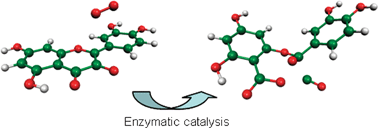Theoretical investigations of the role played by quercetinase enzymes upon the flavonoids oxygenolysis mechanism†
Abstract
Quercetinase enzymatic activity consists in the addition of dioxygen onto

* Corresponding authors
a
Laboratoire de Chimie des Molécules Bioactives et des Arômes, UMR-CNRS 6001, Faculté des Sciences, Université de Nice Sophia Antipolis, Nice Cedex 2, France
E-mail:
Serge.Antonczak@unice.fr
Fax: (+33) 492 07 61 25
Quercetinase enzymatic activity consists in the addition of dioxygen onto

 Please wait while we load your content...
Something went wrong. Try again?
Please wait while we load your content...
Something went wrong. Try again?
S. Antonczak, S. Fiorucci, J. Golebiowski and D. Cabrol-Bass, Phys. Chem. Chem. Phys., 2009, 11, 1491 DOI: 10.1039/B814588A
To request permission to reproduce material from this article, please go to the Copyright Clearance Center request page.
If you are an author contributing to an RSC publication, you do not need to request permission provided correct acknowledgement is given.
If you are the author of this article, you do not need to request permission to reproduce figures and diagrams provided correct acknowledgement is given. If you want to reproduce the whole article in a third-party publication (excluding your thesis/dissertation for which permission is not required) please go to the Copyright Clearance Center request page.
Read more about how to correctly acknowledge RSC content.
 Fetching data from CrossRef.
Fetching data from CrossRef.
This may take some time to load.
Loading related content
